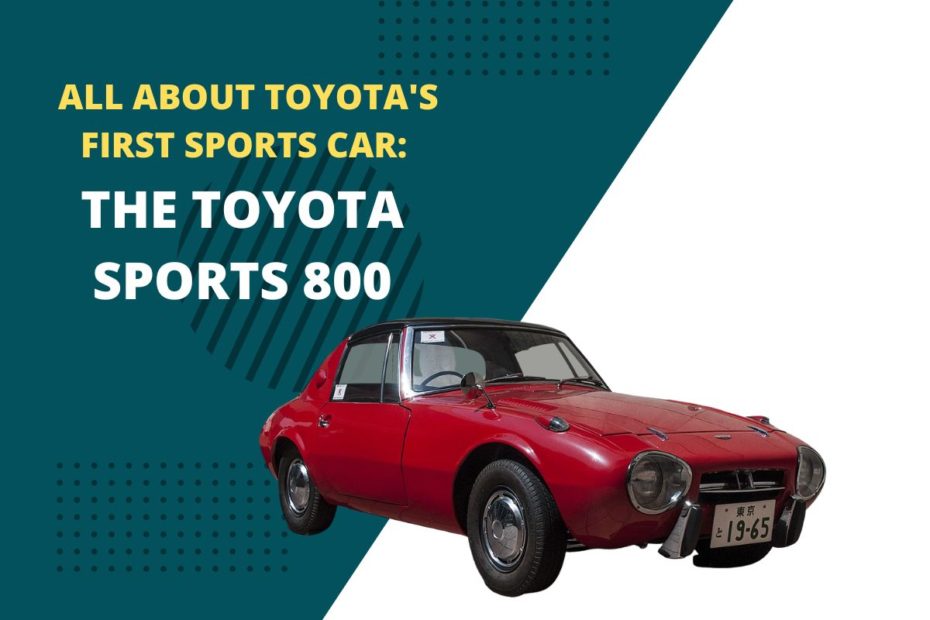In Japan, the Toyota Sports 800, the car company’s first sports car, is considered a legend in its homeland, according to the professionals at Toyota near Irvine.
In 1962 at the Tokyo Auto Show, Toyota showcased the prototype for the Sports 800, also known as the Publica Sports. It featured a sloping fighter-jet style one-piece canopy (without doors). It used a 28-horsepower engine that came from the compact and lightweight Publica 700, a Japanese market economy car that was the older sibling of today’s Toyota Corolla. When the two-seater Toyota Sports 800 officially debuted in 1965, it had to let go of the exciting show concept for a more traditional design, with its engine advancements for more capability.
The Toyota Sports 800 was produced by Toyota’s subcontractor Kanto Auto Works, now under the company, until 1969. Around 3,100 were manufactured, making it one of the rarest Japanese retro masterpieces. Having a head start over the Supra, MR2, 86, and even the 2000GT, it was a perfect sports car in every way, shape, and form. Because it was targeted at the domestic market, it has never gotten much attention from the entire world, but in Japan, the iconic Sports 800 is admired. This is why the Toyota dealer near Irvine loves the Toyota Sports 800.
A Revolutionary Car For Toyota & Japan
Although the 1967 James Bond movie “You Only Live Twice” catapulted the Toyota 2000GT into the world, the Toyota Sports 800 ignited Toyota’s transformation into Japan’s largest car manufacturer. Being Toyota’s first production sports car, it created the path for the Toyota 2000GT and is fundamentally the Supra’s and the Scion FR-S/Toyota GT86’s grandpa.
It has gained a massive following in Japan, endearingly called the “Yota-Hachi” – a Japanese short form for “Toyota 8”. It still is one of the few cars inducted into the Japanese Automotive Hall of Fame because of its significant role in the country’s motoring culture.
Swift, Lightweight, and Fun to Drive Sports Car
The Toyota 800 is a very light vehicle compared to its rivals. The little Toyota only tipped the scale at 1,279 pounds. Even today, it still is zippier and more fun to drive than any of its domestic competitors. Toyota managed to get its light curb weight using a thin-gauged steel unibody, with its hood, roof panel, and trunk lid using aluminum. During the Sports 800’s early years, even the seat frames were constructed from aluminum, similar to the period’s aircraft seat frames.
Had A Cool “Targa” Style Lift-Out Roof
The Toyota Sports 800’s fantastic removable aluminum roof (put together by only six screws) was another weight-saving innovation.
Many believe the roof type was first used by the Porsche 911/912 Targa, which undoubtedly made it trendsetting. Regardless, this is not a fact since the Toyota Sports 800 with its “Surrey Top was the first mass-production car with such a removable roof panel. The Targa-style roof panel could be easily stored in the Sports 800’s trunk when not in use.
The Car’s Classic Design
The Sports 800 probably got some of its notoriety because it looks like an Italian-designed car. Many people were amazed to hear that Toyota made such a fashionable sports car on its first attempt. It’s excellent; Shozo Sato did the semi-convertible design, a designer Datsun let Toyota borrow, and Toyota’s lead engineer Tatsuo Hasegawa.
In the past, Hasegawa worked on the Tachikawa Ki-94 high-altitude fighter-interceptor, a WWII aircraft, and greatly influenced the Sports 800 use of aerospace engineering principles to enhance aerodynamics. The innovative design continues to delight the eyes of classic car enthusiasts today.
Its A Marvel & Collectable
It’s exhilarating to own a classic, fun car similar to the Toyota Sports 800, that’s also remarkably beautiful. Only 3,131 units were manufactured in the four years the Toyota Sports 800 was in production. Even fewer are still around today, reported to be around 10%, with most in Japan.
The reason is that the thin steel used for the unibody turned out to be a double-edged sword. Although it gave it the edge regarding lightness, it also made it more vulnerable to destructive corrosion. Because of the car’s rarity, prices have soared, deeming it collectible. A non-running Sports 800 project car with some rust sold for $40,000 in 2019. Simultaneously, a completely restored Sports 800 had been listed for sale in Switzerland for a mighty $89,000!
A True Left- & Right-Hand Drive
Every genuine Japanese domestic vehicle comes standard with right-hand drive (RHD). However, that’s if you don’t consider the Toyota Sports 800, which could be the first JDM car manufactured in right-hand and left-hand drive. Out of all 3,131 units, less than 300 were left-hand drive cars. They were supposed to be sold in the American-occupied Japanese Okinawa Island, where cars were driven on the right side of the road.
Toyota, being enthusiastic, purchased thirty-one of the LHD Sports 800s stateside for “test marketing” and to build a dealership network. Nevertheless, they were told by American dealerships that the cars wouldn’t sell well in the United States. Still, Toyota decided to leave them in the country instead of shipping them back to Japan.
It Has A Robust Engine
The Toyota Sports 800 was mechanized by a 790-cc air-cooled, horizontally-opposed, dual-carbureted, two-cylinder engine paired to a four-speed manual gearbox transmitting power to its rear wheels. The power plant was so small that one person could carry it around. Based on the company’s estimates, the little mill could generate 45 horsepower while only swallowing fuel at an efficient rate of 73 mpg.
Impressive Performance For Its Time
Although it only produced 45 horsepower, the Toyota Sports 800 was not sitting on its laurels when it came to performance due to its low 1278 pounds curb weight. The power was enough to propel it throughout the quarter-mile in 18.4 seconds, which was exceptional for the time.
